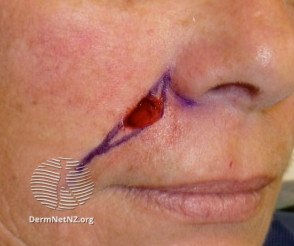
Surgical Excision
During surgical excision, the plan for closure and removal is drawn out so the closure heals flat.
Credit: DermNet NZ
Introduction to Surgical Excision
Surgical excision is a common treatment for atypical skin lesions, skin cancers, and benign growths like cysts and lipomas. The procedure involves local anesthesia with lidocaine, excision of the lesion along with a margin of normal skin, and closure with two layers of stitches—deep stitches that dissolve and top stitches that are removed later.
Post-Procedure Care
Initial 24 Hours: Keep the excised area dry and covered. Avoid showers during this period.
Daily Routine: Starting the day after the procedure, remove the bandage, wash the area with soap and water, and apply Vaseline or Aquaphor over the stitches. Redress it using a large bandage or non-stick dressing like a Telfa Pad, securing it with hypoallergenic Hypafix tape. Repeat daily until stitches are removed.
For Scalp Areas: If the excised area is on the scalp and can't be bandaged, apply a thick layer of Vaseline daily.
Physical Activity: Refrain from strenuous exercises like strength training while stitches are in place.
Water Exposure: Avoid submerging the area in water (baths, swimming pools, hot tubs) until the stitches are removed.
Managing Symptoms and Complications
Pain and Soreness: Mild soreness for the first few days can be managed with over-the-counter pain relievers like ibuprofen or acetaminophen.
Infection: Symptoms like excessive redness, pain, oozing pus, or fever above 100.4°F indicate a possible infection. Contact your doctor for guidance.
Bleeding: If bleeding occurs, apply pressure for 20 minutes. If it persists, try over-the-counter coagulants like BleedStop, especially if you're on blood thinners. Contact your doctor if bleeding continues.
Follow-Up and Long-Term Considerations
Pathology Report: When you return for stitch removal, your pathology report should be available to discuss whether any lesion remains.
Scarring: Expect a line scar that may feel tight, depending on the location on your body.
Recurrence Risks: About 4% of skin cancers treated this way may recur within the first five years. Regular skin checks are advised.
Additional Information
For a more comprehensive guide, please refer to the excision (surgery) instruction sheet provided by your healthcare provider.
